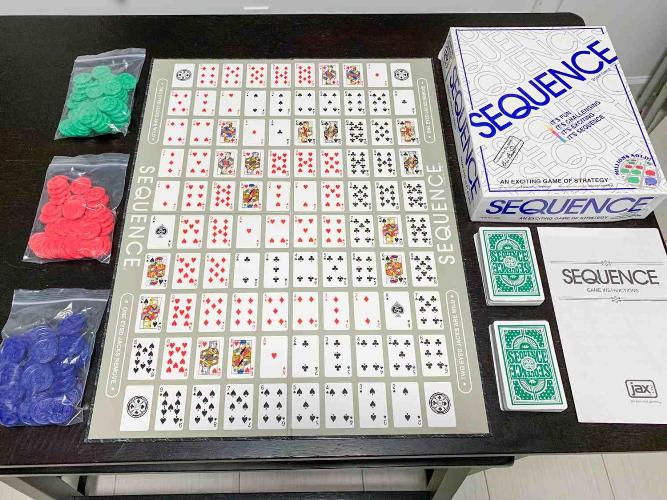
Sequence. COURTESY
Sequence, an abstract strategy board-and-card game, was invented by Douglas Reuter in Owatonna, Minnesota, over a two-year period in the 1970s. Mr. Reuter originally called the game, “Sequence Five”. Reuter spent years developing the concept, and, in June 1981, granted Jax Ltd. an exclusive license to manufacture, distribute and sell the board game, Sequence, and its subsequent variations. The game was first sold in a retail store in 1982.
The object of the game is to form rows of five poker chips on the board by placing the chips on the board spaces corresponding to cards played from the player's hand.
Playing Board 19+3⁄4 by 15+1⁄4 inches (500 mm × 390 mm); Instructions; 135 poker chips (50 blue, 50 green, 35 red); two full standard card decks (52 cards each, 104 cards total).
Sequence can be played with 2 to 12 players. More than 12 players cannot play. If more than three people are playing, they should divide evenly into two or three teams. With two teams, players alternate their physical positions with opponents around the playing surface. With three teams, players of a team must be positioned at every third player around the playing surface.
The game board is placed on a flat surface (such as the floor or a table) with enough room to allow for the draw deck, a discard pile and marker chips. The jokers, if any, are removed from the deck as they are not used in the game.
To decide who goes first, one player shuffles the card decks into two stacks. Each player takes a card from the deck. The player with the lowest card will deal, and the cards are shuffled again. Each player or team then chooses a set of poker chips; all members of each team must use the same color chips (red is only used if there are three teams).
The number of cards dealt to each player varies by the number of people playing:
Two Players: Seven cards each
Three Players: Six cards each
Four Players: Six cards each
Six Players: Five cards each
Eight Players: Four cards each
Nine Players: Four cards each
Ten Players: Three cards each
Twelve Players: Three cards each.
Each card is pictured twice on the game board, and Jacks (while necessary for game strategy) do not appear on the board.
The player to the left of the dealer goes first.
The player chooses a card from their hand, and places a chip on one of the corresponding spaces of the game board (Example: they choose Ace of Diamonds from their hand and place a chip on the Ace of Diamonds on the board). Jacks have special powers. Two-Eyed Jacks can represent any card and may be used to place a chip on any open space on the board. One-Eyed Jacks can remove an opponent's token from a space. Players may use the Two-Eyed Jacks to complete a row or block an opponent, and One-Eyed Jacks can remove an opponent's advantage. One-Eyed Jacks cannot be used to remove a marker chip that is already part of a completed sequence; once a sequence is achieved by a player or team, it stands.
The played card then goes face-up into a “Discard” pile, the player then draws a replacement card from the draw deck, and play passes to the left.
A player may place chips on either of the appropriate card spaces as long as it is not already covered by an opponent's marker chip.
If a player possesses a card which does not have an open space on the game board, the card is considered “dead” and may be exchanged for a new card. When it is their turn, they place the dead on card on the discard pile, announce they are turning in a dead card, and take a replacement (one card per turn). Then they proceed to play their normal turn.






0 Comments